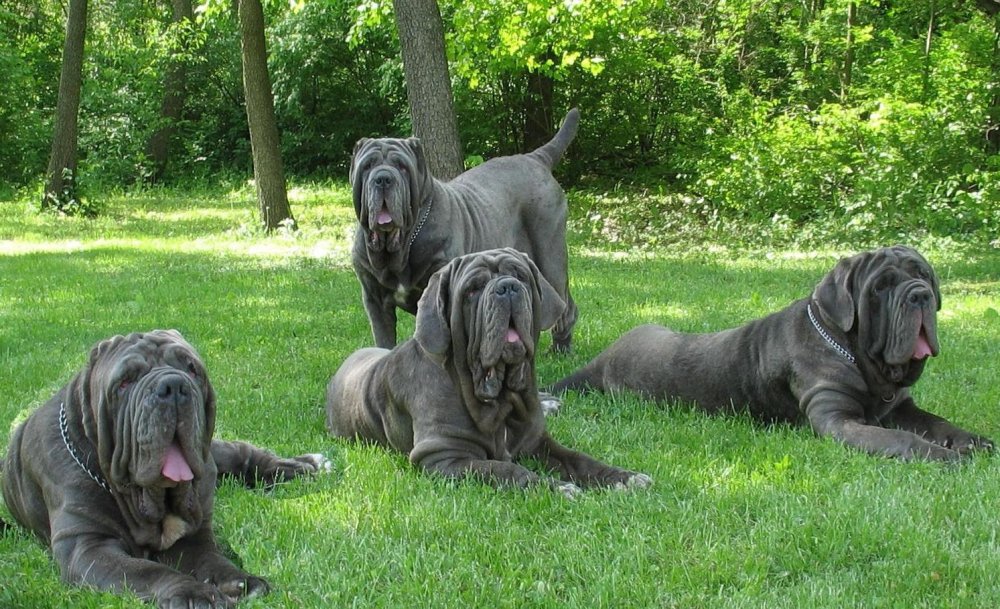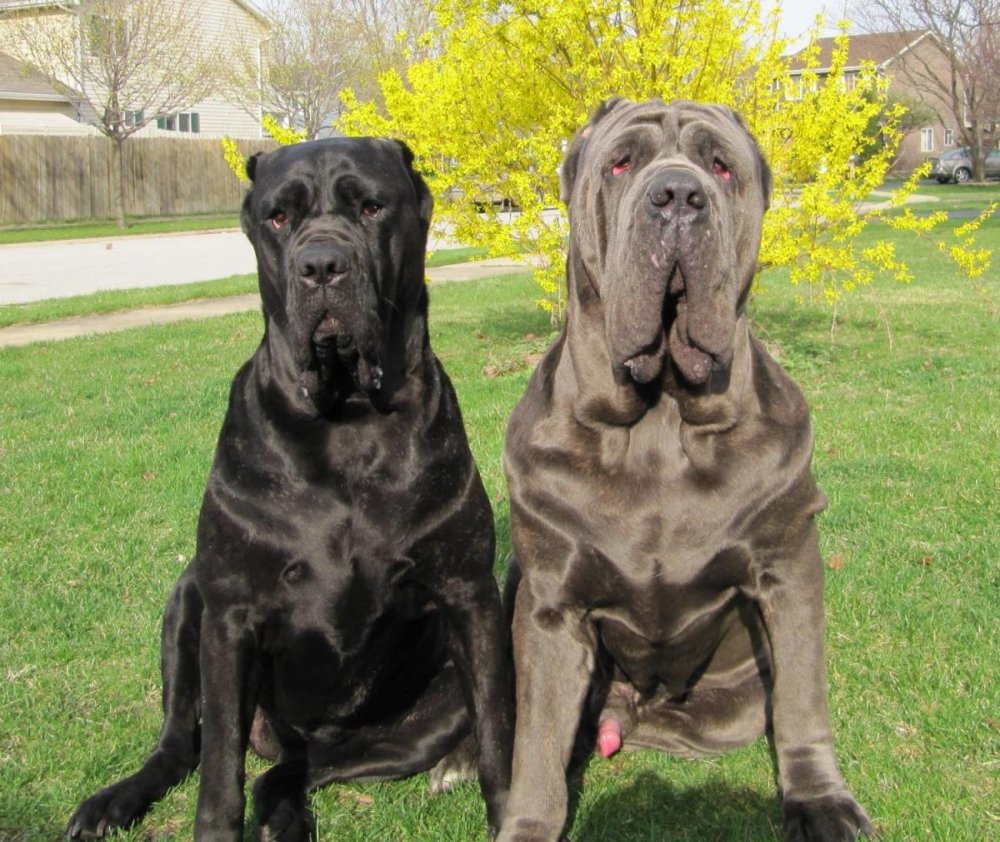- Breed Category: Working Group
- Country of Origin: Italy
- Average Height: Males 65-75 cm, Females 60-70 cm
- Average Weight: Males 60-70 kg, Females 50-60 kg
- Average Life Span: 7-9 years
- Grooming Requirements: Low, occasional brushing
- Exercise Requirements: Moderate, daily walks
- Coat Type: Short and dense
- Coat Color Variations: Black, blue, mahogany, tawny
- Shedding Level: Moderate
- Ear Type: Natural or cropped
- Tail Type: Long, often docked
- Temperament: Loyal, protective, calm
- Intelligence Level: High
- Barking Tendency: Low
- Compatibility with Children: Good with supervision
- Compatibility with Other Pets: Varies, early socialisation needed
- Training Ease: Moderate, requires consistency
- Common Health Issues: Hip dysplasia, heart issues
- Dietary Needs: High-quality, balanced diet
- Energy Level: Low to moderate
- Drooling Tendency: High
- Sensitivity to Weather: Sensitive to heat
- Overall Maintenance Level: Moderate
- Original Purpose: Guard dog
- Year of Recognition by Kennel Clubs: 2004 by AKC
- Apartment Friendly: Not ideal, needs space
- Best Suited For: Experienced dog owners
- Cost of Ownership: High, due to size and health
- Unique Traits: Loose skin, massive size
- Popularity Rank: Moderate
Imagine a creature as ancient as the Roman Empire, yet as loyal as your best mate. The Neapolitan Mastiff is just that—a living relic with a heart of gold. This article dives into the fascinating world of this majestic breed, exploring its unique characteristics, storied history, and essential care tips.
Originating from the Italian peninsula, the Neapolitan Mastiff has roots that trace back to the Roman legions. These dogs were bred for their strength and protective instincts, serving as guardians and companions. Over centuries, they evolved into the gentle giants we know today, with their distinctive loose skin and soulful eyes. Understanding their past helps us appreciate their present, making them a truly remarkable breed.
Neapolitan Mastiff: A Glimpse into History and Characteristics

Early Development and Roman Role
The Neapolitan Mastiff’s journey began in ancient Rome, where they were bred for their formidable presence and protective nature. These dogs were not just pets; they were warriors, standing guard alongside Roman soldiers. Their imposing size and fierce loyalty made them ideal protectors, a role they embraced with vigour.
Key Historical Figures and Events
Throughout history, the Neapolitan Mastiff has been shaped by various breeders and enthusiasts who recognised their unique qualities. One pivotal moment was the post-World War II revival, when Italian breeders worked tirelessly to preserve the breed. This dedication ensured the Neapolitan Mastiff’s survival and continued evolution into the gentle giants we admire today.
Physical Characteristics
With their loose, wrinkled skin and massive frame, Neapolitan Mastiffs are hard to miss. Their soulful eyes and droopy jowls give them a distinctive, endearing appearance. Despite their size, they move with surprising grace, embodying both power and elegance. These physical traits, combined with their loyal nature, make them a standout breed.
Appearance and Unique Traits
The Neapolitan Mastiff is a sight to behold, with its massive build and loose, wrinkled skin. These dogs are truly unique, boasting a coat that comes in shades of grey, black, mahogany, and tawny. Their distinctive wrinkles and folds are not just for show; they give the breed its characteristic look, making them instantly recognisable.
Beyond their size and skin, their eyes are deep and soulful, often hidden beneath droopy eyelids. This adds to their endearing, almost ancient appearance. Despite their formidable size, they carry themselves with a surprising grace, a testament to their well-balanced physique.
Temperament and Behaviour
Neapolitan Mastiffs are known for their calm and steady temperament. They are incredibly loyal and protective, making them excellent family guardians. While they may appear intimidating, they are gentle giants at heart, often forming strong bonds with their human companions.
These dogs are naturally wary of strangers, a trait that makes them excellent watchdogs. However, with proper socialisation, they can be friendly and accepting of new people and situations. Their behaviour is a blend of confidence and affection, making them a cherished addition to any household.
Neapolitan Mastiff: Personality and Family Suitability
Typical Personality Traits
Neapolitan Mastiffs are the epitome of loyalty and protectiveness. These dogs are calm and composed, often exuding a sense of quiet confidence. Their protective nature makes them natural guardians, always keeping a watchful eye over their family. Despite their imposing presence, they are gentle and affectionate with those they trust.
Suitability as a Family Pet and Guard Dog
As family pets, Neapolitan Mastiffs are a fantastic choice. Their loyalty and protective instincts make them excellent companions for families. They are naturally inclined to guard their home, providing a sense of security. However, their gentle nature ensures they are loving and devoted to their family members.
Interaction with Children and Other Animals
These dogs are generally good with children, often displaying patience and tolerance. Their calm demeanour makes them suitable playmates, though supervision is recommended due to their size. With proper socialisation, they can coexist peacefully with other animals, although they may be wary of unfamiliar dogs.
Training and Exercise Needs
Training a Neapolitan Mastiff requires consistency and patience. They respond well to positive reinforcement and need early socialisation to ensure they are well-adjusted. Regular exercise is essential to keep them healthy, but they don’t require excessive activity. A daily walk and some playtime will suffice to keep them content.
Neapolitan Mastiff: Training, Exercise, and Health

Importance of Early Training and Socialisation
Getting a Neapolitan Mastiff off to a good start with early training and socialisation is crucial. These dogs are naturally protective, so introducing them to different people, environments, and other animals early on helps them grow into well-rounded adults. It’s all about building their confidence and ensuring they’re comfortable in various situations.
Recommended Training Techniques
When it comes to training, positive reinforcement is the way to go. These dogs respond well to rewards and praise, so keep the sessions fun and engaging. Consistency is key, and a firm yet gentle approach works best. Remember, patience is your best friend here.
Daily Exercise Requirements and Activities They Enjoy
Neapolitan Mastiffs don’t need a marathon run every day, but they do enjoy a good walk and some playtime. A daily stroll and a bit of interactive play keep them happy and healthy. They love activities that engage their minds as well as their bodies, so mix it up with some puzzle toys or training games.
Health and Lifespan
These majestic dogs typically live between 8 to 10 years. Regular vet check-ups are essential to monitor their health, especially for common issues like hip dysplasia and skin infections. A balanced diet and proper exercise go a long way in ensuring they lead a healthy life.
Neapolitan Mastiff: Health, Care, and Grooming

Common Health Issues
Neapolitan Mastiffs are prone to certain health issues, including hip dysplasia, heart problems, and skin infections due to their loose skin. Regular vet visits are crucial to catch any potential problems early. Keeping an eye on their weight can also help prevent joint issues.
Average Lifespan and Health Tips
These gentle giants typically live between 8 to 10 years. To keep them healthy, ensure they have a balanced diet and regular exercise. A daily walk and some playtime are usually enough to keep them fit and happy. Don’t forget mental stimulation; puzzle toys can work wonders.
Preventative Care Recommendations
Regular check-ups with the vet are a must. Vaccinations, dental care, and parasite prevention should be part of their routine. Monitoring their skin for infections and maintaining a healthy weight are also key to their wellbeing.
Grooming and Maintenance
Grooming a Neapolitan Mastiff involves regular brushing to keep their coat healthy and reduce shedding. Pay special attention to cleaning their skin folds to prevent infections. Bathing them occasionally and keeping their nails trimmed will also help maintain their overall hygiene.
Neapolitan Mastiff: Coat Care, Grooming, and Nutrition

Coat Care and Grooming Routines
Neapolitan Mastiffs have a short, dense coat that requires regular attention. A weekly brush with a soft-bristle brush or grooming mitt helps remove loose hair and keeps their coat looking its best. Pay special attention to their skin folds, as these areas can trap moisture and lead to infections. A gentle wipe with a damp cloth can help keep these folds clean and dry.
Shedding and Seasonal Grooming Tips
These dogs do shed, particularly during seasonal changes. During these times, more frequent brushing can help manage the extra hair. A good quality deshedding tool can be handy to keep your home fur-free. Regular grooming not only helps with shedding but also strengthens the bond between you and your dog.
Diet and Nutrition
A balanced diet is crucial for the health of a Neapolitan Mastiff. High-quality dog food that meets their nutritional needs is essential. Look for options rich in protein and healthy fats to support their large frame and energy levels. Avoid overfeeding, as obesity can lead to joint issues. Fresh water should always be available, and occasional treats can be given as part of their training routine.
Nutritional Needs and Feeding Tips for Neapolitan Mastiffs
Nutritional Needs for Optimal Health
Neapolitan Mastiffs thrive on a diet rich in protein and healthy fats. These nutrients support their muscular build and energy levels. Look for high-quality dog food that lists meat as the first ingredient. Omega-3 fatty acids are also beneficial for their skin and coat health.
Foods to Include and Avoid
Include lean meats, fish, and vegetables in their diet. Avoid foods high in fillers, artificial preservatives, and excessive grains. These can lead to weight gain and digestive issues. Fresh fruits like apples and blueberries can be given as occasional treats.
Feeding Schedules and Portion Recommendations
Feed adult Neapolitan Mastiffs twice a day to maintain a healthy weight. Puppies may require three to four smaller meals daily. Portion sizes depend on their age, weight, and activity level, so consult your vet for personalised advice.
Fun Facts and Trivia
- Neapolitan Mastiffs were once used in Roman arenas, showcasing their strength and bravery.
- Their distinctive wrinkles were believed to protect them in battles, acting as a shield against bites.
- Despite their size, they are known for their gentle and affectionate nature, often referred to as “gentle giants.”
Neapolitan Mastiff: Interesting Tidbits and Famous Appearances

Interesting Tidbits about the Breed
Neapolitan Mastiffs are not just known for their size and wrinkles; they have some fascinating quirks. For instance, their droopy skin isn’t just for looks. Historically, it was thought to protect them in fights, allowing them to twist and turn even when grabbed. These dogs also have a unique way of communicating. They often use a range of vocalisations, from grumbles to snorts, to express themselves. It’s like having a conversation with a furry friend!
Famous Neapolitan Mastiffs in Media or History
In the world of film, Neapolitan Mastiffs have made their mark. One of the most famous appearances is in the “Harry Potter” series, where a Neapolitan Mastiff played the role of Fang, Hagrid’s loyal companion. This role showcased their gentle nature and impressive presence. Beyond the silver screen, these dogs have been admired by historical figures, including Alexander the Great, who reportedly used similar breeds in his conquests. Their legacy as loyal protectors and companions continues to this day.
Final Thoughts

The Neapolitan Mastiff is a majestic blend of history and loyalty. This breed’s ancient roots and protective nature make it a unique companion. While they require dedicated care and training, the rewards of their companionship are immense. Their journey from Roman guardians to gentle giants highlights their enduring appeal and adaptability. For those ready to embrace the challenge, the Neapolitan Mastiff offers a lifetime of loyalty and love.
